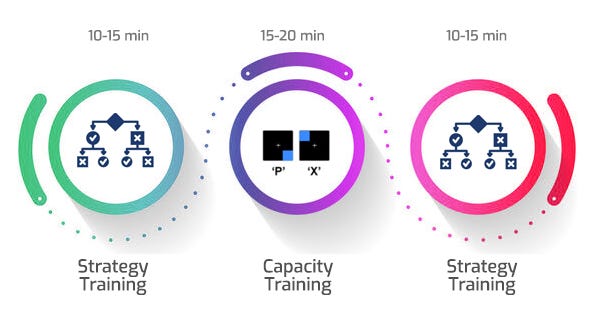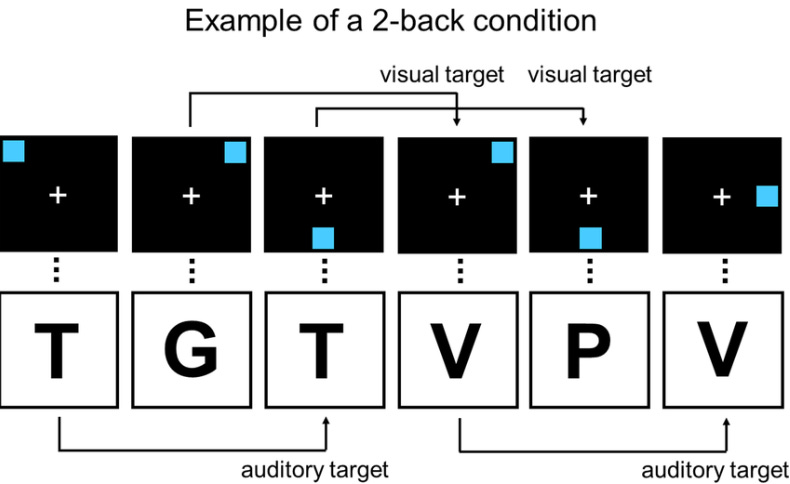In our pursuit of cognitive ability, two meta functions of general intelligence (g) stand out as fundamental:
(1) Strategic action to attain our goals, explore and experiment
(2) Perceiving and understanding the world around us and imagining new possibilites
IQ Mindware’s Capacity-Strategy Brain Training applies state-of-the-art cognitive neuroscience to target and build capacity for both g functions in two 4 week training modules. Efficient and flexible decision-making, problem-solving, and learning are fundamental to both programs.
The Synergy of the Capacity-Strategy Brain Training Method
At the heart of both programs is a unique training protocol: the Capacity-Strategy Brain Training Method, which sandwiches one 15-20 minute session of n-back working memory and attention training between two 10-15 minute strategy training sessions. This structure creates a powerful synergy between working memory capacity building and strategy development.
Why the Combination Works
Many training programs focus either on building raw cognitive capacity or on teaching specific strategies. The Capacity-Strategy Brain Training Method bridges this gap by recognising that capacity and strategy are interdependent.
Capacity without strategy is directionless.
Strategy without capacity is limited by the mental bandwidth available to apply it.
By combining the two, this method ensures that:
You not only learn strategies but also have the cognitive resources to apply them effectively, even in challenging or high-pressure situations.
The gains in working memory and attention from n-back training translate directly into improved real-world performance, as they support the execution of increasingly complex strategic tasks.
Example Strategy-Capacity Training
Here’s a practical example of a strategic action module strategy designed to align with n-back training. We call a specific set of steps the ‘mindware’ for this strategy.
Strategy: Problem Space Analysis and KPIs
Objective: Define the problem space and establish measurable Key Performance Indicators (KPIs) as a foundation for strategic action.
Mindware
Set Timer: Allocate 5 minutes for this exercise.
Understand the Goal: Read and internalise the scenario's desired outcome.
Problem Space Analysis:
Initial State: What is the current situation? List key facts or conditions.
Goal State: Define the specific, measurable outcome that signifies success.
Constraints: Identify any challenges or limitations that could impact progress.
Mission Statement: Craft a 1-sentence mission statement that summarises the problem space.
Define Objectives:
Start with 2 key objectives that support the mission.
Add more objectives if necessary as your skills progress.
Set KPIs:
For each objective, establish 1 measurable KPI (e.g., time, quantity, quality) to track your progress.
Summarise:
Mentally or verbally summarise:
Mission statement
Objectives
KPIs
Highlights of the problem space (initial state, goal state, constraints)
With practice, this 6 step mindware can be applied quickly and fluently, and the method becomes stored long-term as a part of your crystallized intelligence.
N-Back Training
Dual n-back training is sandwiched between two sessions of strategy training.
The adaptive dual n-back game, a core part of the Capacity-Strategy Brain Training Method, is designed to enhance working memory and attention control. Here’s a quick breakdown of how it works, using the 2-back condition illustrated above.
How the Dual N-Back Works
Task: In each session, players are presented with sequences of visual and auditory stimuli. In the example above, each square (visual) and letter (auditory) appears sequentially - for about 3 seconds between each transition.
Objective: The player’s task is to remember and match the position of the square and the letter from two steps back in the sequence (hence the term "2-back"). In this illustration:
For the visual task, the blue square appears in the same position as it did two moves earlier.
For the auditory task, the letter matches the one presented two moves earlier.
Challenge: As players progress, the "n-back" level adapts to match their working memory performance. If they perform well, the game increases to a 3-back or higher, requiring them to remember events from three steps back. If they struggle, the level decreases to reduce cognitive load.
Purpose of the N-Back Game
The dual n-back game targets working memory and attention control, training the brain to handle multiple pieces of information over short intervals. As working memory improves, players can track more information and sustain focus, supporting the cognitive load of more complex strategies in the Capacity-Strategy Brain Training Program.
By increasing the level adaptively, the dual n-back game continuously challenges players just at the edge of their cognitive capacity, optimising working memory growth and providing a dynamic measure of the user's real-time memory capacity.
Adjusting Cognitive Load of Strategy Exercises Based on Current N-back Level In Your Training
Cognitive load refers to the amount of mental effort and capacity required to process and apply information during a task. In the context of our strategy exercises, cognitive load involves managing and integrating various elements - like objectives, KPIs, and constraints - while maintaining clarity and focus. As your working memory capacity grows through the n-back training, you can handle increasingly complex strategic exercises, allowing for deeper and more effective problem-solving. This raises your IQ.
To make this process manageable and aligned with your current cognitive capacity, your n-back level serves as a guide for choosing the complexity of your daily strategy exercises.
Here’s how to adapt based on your current n-back level - for the problem space mindware we looked at - shown again in the diagram:
N-back level = 2
Objectives: Include 2 objectives in your problem space analysis to focus your strategic planning.
KPIs: Establish 2 key performance indicators (KPIs), one for each objective, to keep tracking manageable.
Constraints: Keep constraints relatively simple, focusing on one or two primary challenges that affect your goals directly.
Cognitive Load Effect: This level allows you to focus on foundational elements without overwhelming your working memory, creating a manageable cognitive load as you build strategic clarity.
N-back level = 3
Objectives: Increase to 3 objectives in your problem space analysis, adding depth to your planning.
KPIs: Set 3 KPIs, allowing for a more detailed tracking approach that still aligns with your current capacity.
Constraints: Introduce a moderate level of complexity in constraints, allowing for some interdependent factors that require more complex thinking.
Cognitive Load Effect: With three objectives and KPIs, you’re pushing your working memory to manage a more complex framework, balancing between maintaining focus and integrating multiple elements.
N-back level = 4+
Objectives: Expand to 4 or more objectives, crafting a comprehensive problem space that covers all relevant aspects of your strategic goal.
KPIs: Define 4+ KPIs to allow for in-depth measurement and monitoring of progress.
Constraints: Embrace a high level of complexity in constraints, with multiple, interrelated challenges.
Cognitive Load Effect: At this level, you are exercising higher-order integration skills, as your working memory supports you in handling a multifaceted strategy that requires balancing priorities and interconnections.
Synchronising Working Memory Development with Strategy Complexity
This adaptive approach to cognitive load ensures that as your working memory capacity increases, so does your ability to handle higher level strategy exercises. Each progression in n-back level allows you to add complexity to the problem space exercise, providing a steady growth path in both capacity and strategic thinking.
By synchronising working memory development with strategic complexity, you create a natural feedback loop: increased working memory capacity enables you to manage more intricate strategies, while practising these strategies further reinforces and challenges your cognitive resources. This integrated model cultivates both cognitive resilience and strategic adaptability, equipping you to handle real-world problem spaces with agility and clarity.
Substack Strategic Action Program Moving Forward
Here’s the full summary of the 24-day Strategic Action Program which will be developed in my Substack articles over the next month. Following this I will cover the Comprehension/Understanding Program.
Week 1: Defining the Problem Space and Strategic Planning
Problem Space Analysis and KPIs: Establish problem scope, mission, and measurable objectives.
SWOT Analysis and Logic Models: Assess internal/external factors and connect resources, activities, and outcomes.
Stakeholder-Centric Analysis (Empathy Mapping): Align objectives with key stakeholder needs and expectations.
Positional Advantage Strategy: Identify strengths to secure short- and long-term advantages.
Refining Objectives and Prioritisation: Rank objectives using prioritisation frameworks (e.g., Eisenhower Matrix, MoSCoW).
Strategic Plan Consolidation: Integrate findings into a cohesive, actionable strategic plan.
Week 2: Adaptive Planning and Early Execution
Adaptive Planning (Plan A/Plan B Strategies): Prepare flexible approaches to address potential risks.
Premortem Analysis and Game Theory Basics: Anticipate challenges and consider competitive or collaborative dynamics.
Execution Phase 1 (Agile Sprint 1): Begin implementing top-priority tasks with daily check-ins and adjustments.
Iterative Feedback Loops: Use early feedback to refine objectives and adjust priorities as needed.
Real-Time Prioritisation: Practise adjusting task priority dynamically using frameworks like the Eisenhower Matrix.
Agile Stand-Up Reflection: Review progress and obstacles quickly in a stand-up format to maintain momentum.
Weeks 3 & 4: Execution, Monitoring, and Adjustments
Execution Phase 2 (Agile Sprint 2): Continue executing objectives, making daily task adjustments.
Monitoring KPIs: Track progress against KPIs, adjusting as needed for mission alignment.
Double-Loop Learning: Reflect on assumptions, revising strategies if underlying premises are flawed.
OODA Loop (Observe, Orient, Decide, Act): Apply a rapid decision-making cycle to adapt in real time.
Midpoint Review and Adjustments: Conduct a detailed review to refine strategies for the program's second half.
Iterative Execution and Feedback (Agile Sprint 3): Continue executing tasks while integrating real-time feedback.
Pattern Recognition for Efficiency: Identify recurring challenges and adjust based on insights.
Real-Time Prioritisation Refinement: Practise using prioritisation strategies in moment-to-moment decision-making.
Days 21–24: Scenario Reassessment and Strategic Reflection
Scenario Reassessments with Game Theory Dynamics: Adapt plans to shifting external factors using competitive and collaborative insights.
Final Strategy Consolidation: Re-evaluate all insights, synthesising them into a refined strategy.
Reflective Integration of Strategies: Practise combining different strategies for more complex, dynamic problem-solving.
Final Reflection and Strategic Insights: Reflect on the entire process, extracting lessons and preparing for future applications.
Increase Your IQ
This Strategic Action Program is designed to enhance one of the two fundamental meta-functions of general intelligence (g): strategic action toward goal attainment. Through daily practice in structured planning, execution, and adaptability techniques, the program supports the development of both working memory capacity and strategic thinking. Each strategy is crafted to be manageable yet progressively challenging, allowing for continuous expansion of cognitive ability.
In summary, the 4 week program equips participants with the strategies and capacity to navigate complex, dynamic situations across personal and professional domains with greater effectiveness and a higher IQ.










Dr. Ashton Smith, I would like to thank you, first off, for the amazing work you do. You have certainly enriched my life both with the content you release and your capacity training app. In fact, I've used your capacity training app for several years now and have experienced life-changing benefits from it. However, I do find myself not as challenged as before. I can consistently perform around 5-back in 2G+. I was wondering if you have considered implementing novel binary logical operators such as NOR, NAND, XNOR, etc., to the application. It seems, prima facie, that they might increase the cognitive load of the tasks. I would love to hear what you think. And once again, thank you for work you do.
I really greatly appreciate the drive to link working memory capacity training to strategic action for real life goal attainment. This really sets you apart from other brain training apps. To further improve the value added for your readers it would be great to focus on concrete real world exemples instead of giving only a conceptual framework that leaves too much work to the reader who wishes to implement practical changes in his approach to intellectual work. A case study on how the framework actually led to higher order change would be very much appreciated. Thank you for all the work you put into your blog posts who are of exceptional quality and intellectually stimulating. I am also wondering if you could think about how to integrate external intelligence in the form of LLMs into your framework as practically every knowledge worker is using them. Again this would bring your academic style concepts closer to real professional world applications and potentially widen your audience. Keep up the good work! Marco